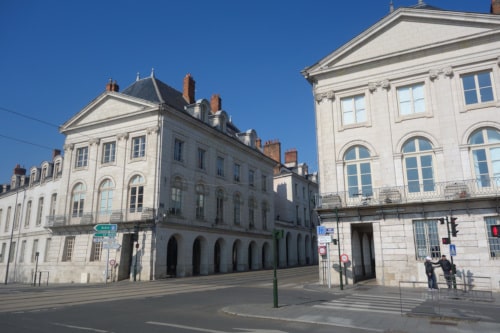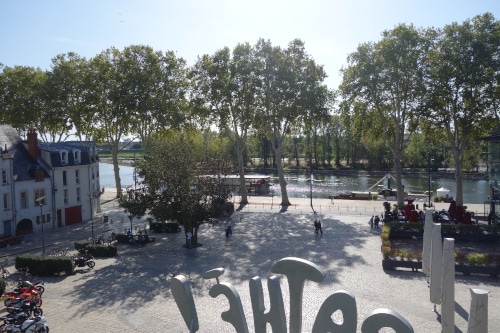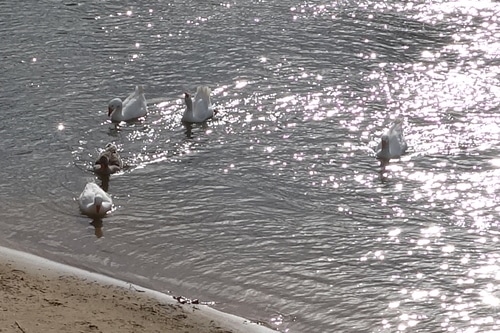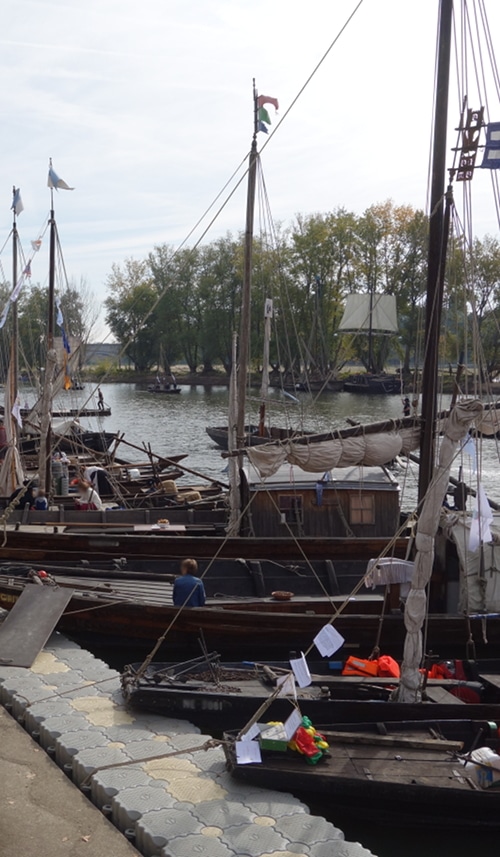Orléans Loire River Banks
Orléans as all the Loire Valley cities is closely linked to the royal river. Till the 19th century, the port of Orléans was the main economic center of the city. Nowadays the quays of the right banks of the Loire River are Orléans’s most popular stroll place. They are also the backbone of this amazing Orléans walking tour.

View of the Loire’s quay at the level of the two pavilions of the rue Royale. They mark since the 18th century the south entry of Orléans. Photo © Broaden horizons
Orléans Loire Banks Guided Tour in a Nutshell
69 € for 1 to 2 people + 7 € per extra person
- Private +/- 2-hour walking Tour in English
- Really private tour = your party only (6 people max.)
- Postgraduate (MPhil) certified French national guide
- Flexible schedule 7/7 if available
- Online booking & payment
Tour end planed close to Thinat bridge = +/- 0.9 Km from city center (Cathedral)
KNOW MORE / BOOK NOW
Your Private Guide in Orléans
Certified French national guide.
Centre-Loire Valley Region accreditation (VAH).
BA, Magna cum laude, Heritage Developpement & Preservation at Conservatoire des Arts et Métiers.
Postgraduate (MPhil) from Paris Dauphine-PSL University.
Why an Orléans Loire Banks Guided Tour
This Orléans guided tour is first of all the opportunity of a nice stroll alongside the Loire River. A Loire River bank tour is without a doubt a very good way to discover and understand any Loire Valley city.
In Orléans it is perhaps even more a good idea as a route alongside the river enable to evoke a large number of historical milestones of the city and beyond that of France and Europe.
- The Gaul city of the Carnutes
- Julius Caesar and Gallic War
- The Gallo-Roman city Cenabum, then Aurelanium
- The twilight of the Western Roman Empire: saint Aignan, Aetius and Attila
- The Middle Ages
- Former River Loire handicraft
- Joan of Arc
- Renaissance
- The French Wars of Religion (St. Bartholomew’s Day massacre)
- 17th century Orléans Royal Glass factory
- 18th century urbanism
- The former Orléans port, its integration in the Atlantic Trade
- Former sugar, vinegar and cotton industries
- The canal d’Orléans
- Post WWII city reconstruction

The beginning of the Canal d’Orléans that we will normally cross at the end of the tour. Photo © Broaden Horizons
A Glimpse On the TOUR Points of Interest
All along our Loire Banks tour in Orléans we will cross numerous monuments, points of interest and landmarks, with among them:
- Notre-Dame de Recouvrance church
- Demeure des Jogues (18th- century mansion)
- George V Bridge and the Royal street
- Half-timber houses
- Middle Ages (gothic) stone houses
- Renaissance houses
- 18th-century neoclassical buildings
- Gallo-Roman city wall remains
- Tour Blanche (White Tower)
- Former Sugar refinery Guinebault
- Former vinegar factory Dessault
- Loire’s quays
- Écluse du Canal d’Orléans
- Saint-Pierre-le-Puellier collegiate
- Saint-Aignan collegiate
- Maison du Roi (Louis XI)
- Maison Coligny
- Former artillery school (1874)
- Château de la Motte-Sanguin (1788-1792)
Evocation of Disappeared Edifices
In the tour route we will also evoke some disappeared historical buildings as for example:
- The Châtelet
- Des Tourelles Bridge (Joan of d’Arc Bridge)
- The domus (palatial Merovingian building)
- The Tour Neuve
- Gallo-Roman Arena
- The cotton factory
Know the Loire in Orléans
The Loire banks guided tour in Orléans is also an opportunity to better know the River:
The Loire in Orléans, its Evolution Through the Ages
- Geology
- Grande Loire
- Petite Loire
- Loiret
Loire Planning and Landscaping
- Dykes
- Quays
- Bridges
- Canal
Loire Inland Water Shipping
A common characteristic of the traditional Loire Valley’s skiffs is that they are all of them traditional flat-bottomed boats to ease the navigation during summer Loire low water levels. Various boat types were used:
- The gabarde, the biggest boat used for merchandise transport
- The toue for fishing
- The toue cabanée, for fishing but with a cabin (in French: cabane)
- The fûtreau, used as ferryboat
Every two years, during the Festival de Loire, in September, can be seen in Orléans an impressive gathering of these historical boats.

Traditional flat-bottomed Loire boats during the Orléans 2017 Loire Festival. This event which occurs every two years in September is considered the biggest riverboats gathering in Europe. Photo © Broaden Horizons.
The rest of the time few boats are generally moored to the quays (the former Orléans’s wharfs). At the quays is also moored the Inexplosible which is a reproduction of a 19th century paddle steamer, these kinds of boats were cruising during few years on the River Loire just before the collapse of the Orléans port due to the railway developement all over France.

The place de Loire in the old city center is a very popular place in Orléans. In the background moored to the quay is the Inexplosive reproduction of a 19th-century steamboat. Photo © Broaden Horizons.
Loire Fauna and Flora
With a little luck and attention, we may have even if being in the city a glimpse of certain of the natural aspects of the Loire River.

The Loire River is often called the last wild river in Europe fauna and flora can often be observed including in cities. Photo Swans on the Loire. © Broaden Horizons
Things to know before Booking
Meeting Point
Intersection of rue de la Chèvre Qui Danse & rue Notre-Dame de la Recouvrance
Access: Tram Line A or Line B, station De Gaulle.
Attention Points
- Tour is on foot.
- Prices do not include transportation, food, drinks or any other extra services.
- Neighborhood tour: we don’t enter in monuments unless otherwise specified.
- Tour duration & content are purely indicative, they may vary due to contingencies.
- Weather: the tour will start on schedule rain or shine.
Tour is normally planned to end at the limit of the city center close to pont Thinat (bridge). You will have to walk +/- 900 meters to return to the hyper city center (Cathedral).
Book the Orléans Loire Banks Walking Tour
Choose below your tour: You will then be asked : -> choose the number of people, date & hours of visit -> after our validation-> pay on line.
Orléans Loire Banks Tour
2 hours private walking tour- For 1 to 2 people + 7 € per extra person
- A group exclusively yours of up to 6 people

Guided tour “The Loire Banks in Orléans”. Photo gathering of traditional Loire River flat-bottomed boat during the Loire Festival. Orléans, Loire Valley, France. Photo © Broaden Horizons


